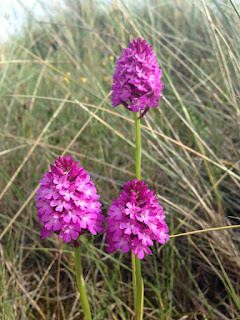With strong winds and heavy rain, it felt like autumn on Saturday morning. Although the first weekend of the summer holiday, we witnessed the appearance of our first autumn migrant of the year: a Black Redstart around the Lifeboat House.
Big waves on Saturday (Sarah Johnson)
Northwesterly winds pushed the large crashing waves up high, dramatically re-profiling the shingle ridge. We braved being sand-blasted for half an hour to record passing seabirds pushed closer in-land by the weather. Amongst dozens of Gannets were seven Manx Shearwaters and two Sooty Shearwaters moving east.
Crashing waves are one of the most evocative sounds of the coast. Paul recently wrote an article about "A Year of Sounds on Blakeney Point", which is well worth a read.
A full brood of four Ringed Plover chicks hatched near the Lifeboat House on Friday and managed to survive the heavy rain and wind. There are now several flying juvenile Oystercatchers - identifiable by the dark tip to their bill - and three family groups of Grey Partridges in the dunes.
Adult Ringed Plover (Ian Ward)
After a slow and uncertain start to the season, things are looking great for the Point's Little Terns. Friday saw nine flying juveniles near the Watch House. Today another five were added to the list, plus two almost ready to fly and another two flying near the Gap. We expect up to 21 to fledge this year (three times more than last year's seven), which constitutes a good year for Little Terns.
Adult Little Tern (Ian Ward)
Other recent bird sightings include several Green Sandpipers. One morning, following heavy rain and strong winds, a Barn Owl was seen flying over the main dunes. A day-flying summer record is actually an extreme rarity on the Point, having previously only been recorded in winter.
Recent invertebrate sightings included a very rarely-recorded leucistic Gatekeeper butterfly (probably a first for the Point) seen by Paul plus a couple of Elephant Hawkmoth larvae feeding on Rosebay Willowherb in the main dunes...
Visitors to the Norfolk Coast are currently enjoying the Common Sea-lavender, which is at its best now, turning the saltmarsh into a haze of delicate purple.
Common Sea-lavender close-up (Ian Ward)
Another plant currently showing in all its finery is Sea Spurge, with its red stems and bright green leaves...
Late July to August is a good time to see this summer's Common Seal pups on the Point. We recommend the seal ferry trips that go from Morston Quay.
Common Seal pup on the beach this week
It looks set to rain for most of the coming week, but we will be out and about every day carrying out our research work, patrolling and meeting visitors who have ventured out to the Point.
- Ajay

































